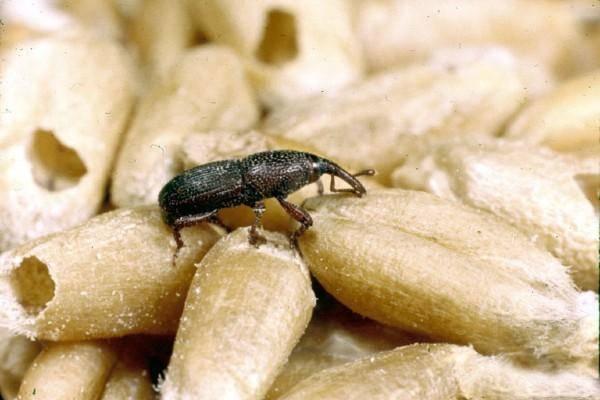About rice and granary weevils
-
Rice weevils are important pests of stored grain worldwide.
-
The adults are 1/8" long, have a distinct snout, and are dull reddish-brown with 4 faint reddish to yellowish marks on the wing covers (elytra).
-
The adults can fly and are attracted to light. The larvae (immature weevils) are legless and creamy-white with a brownish-black head.
-
They attack corn, wheat, rice, beans, nuts, cereals, rye, buckwheat, stored cotton, wheat products, and grapes. It will also feed on apples and pears.
Granary weevil
-
A similar weevil that infests stored products is the Granary weevil.
-
It is 1/8-1/4" long and reddish-brown to black. It does not have the pale spots that the rice weevils have.
-
This weevil cannot fly and is not attracted to light.
-
The larvae are legless and white with a dark head. It attacks a variety of grain and grain products.

Granary weevil (Sitophilus granarius) on wheat. Photo: Clemson University - USDA Cooperative Extension Slide Series, Bugwood.org
Damage
-
Finding webbing or a large number of worm-like larva (immature insect stage) or beetles crawling about in a box or container of cereal or spices is often the first indication of an infestation.
-
Discard infested products. A quick check of other nearby containers should be made. If no additional insects are seen, it may be assumed that the infestation was limited to that area.
-
However, if the first indication is the occurrence of insects crawling or flying about outside of a package, then a more thorough search for the source of the pests is necessary.
-
All containers of dry packaged foods such as nutmeats, dried fruits, flour, meal, pasta, breakfast cereals, or spices (especially red pepper, paprika, and chili powder) must be examined carefully. They sometimes will infest dried flowers. Adults and small worm-like larvae may be found.
-
Sawdust-like droppings, called frass, may also be found.
-
Unopened containers must also be checked to be sure that pests have not gained entry.
Management
-
Prevention is the best control for pantry pests.
-
When purchasing bulk grains, dried fruit, flour, etc., inspect it carefully when loading it into bags for weighing.
-
Inspect products again when you get it home and put it into storage containers. Keep food in glass jars, plastic containers, or metal canisters. Glass jars that pressure seal with rubber gaskets are the best. Make sure they have tight-fitting lids. Many of the pantry pests are very small and can crawl under loose-fitting lids.
-
Do not store products in plastic bags, or cardboard boxes as the insects can chew through them.
-
Try to store foods in a cool dry place. Most of the stored product pests multiply faster at higher humidity. Many products can be kept in the freezer to prevent infestation, especially products that are not used right away. Nuts, flours, meals, and dried chili peppers can all be frozen.
-
Infested foods should be thrown away and the shelves cleaned thoroughly to eliminate food material and insect eggs or larvae which might be in cracks or corners.
-
Vacuum the shelves and then wash the cupboards with warm soapy water. Do not spray any food storage areas with insecticides. Clean up any food spills promptly.
Rev. 2020
